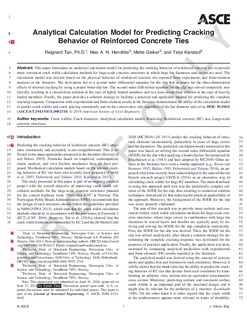| dc.contributor.author | Tan, Jesus Reignard Medel | |
| dc.contributor.author | Hendriks, Max | |
| dc.contributor.author | Geiker, Mette Rica | |
| dc.contributor.author | Kanstad, Terje | |
| dc.date.accessioned | 2020-03-17T14:54:36Z | |
| dc.date.available | 2020-03-17T14:54:36Z | |
| dc.date.created | 2019-12-12T19:26:36Z | |
| dc.date.issued | 2020 | |
| dc.identifier.citation | Journal of Structural Engineering. 2020, 146 (2), . | nb_NO |
| dc.identifier.issn | 0733-9445 | |
| dc.identifier.uri | http://hdl.handle.net/11250/2647257 | |
| dc.description.abstract | This paper formulates an analytical calculation model for predicting the cracking behavior of reinforced concrete ties to provide more consistent crack width calculation methods for large-scale concrete structures in which large bar diameters and covers are used. The calculation model was derived based on the physical behavior of reinforced concrete ties reported from experiments and finite-element analyses in the literature. The derivations led to a second order differential equation for the slip that accounts for the three-dimensional effects of internal cracking by using a proper bond-slip law. The second order differential equation for the slip was solved completely analytically, resulting in a closed-form solution in the case of lightly loaded members and in a non-closed-form solution in the case of heavily loaded members. Finally, the paper provides a solution strategy to facilitate a practical and applicable method for predicting the complete cracking response. Comparison with experimental and finite-element results in the literature demonstrated the ability of the calculation model to predict crack widths and crack spacing consistently and on the conservative side regardless of the bar diameter and cover. | nb_NO |
| dc.language.iso | eng | nb_NO |
| dc.publisher | American Society of Civil Engineers | nb_NO |
| dc.title | Analytical Calculation Model for Predicting Cracking Behavior of Reinforced Concrete Ties | nb_NO |
| dc.type | Journal article | nb_NO |
| dc.type | Peer reviewed | nb_NO |
| dc.description.version | acceptedVersion | nb_NO |
| dc.source.pagenumber | 17 | nb_NO |
| dc.source.volume | 146 | nb_NO |
| dc.source.journal | Journal of Structural Engineering | nb_NO |
| dc.source.issue | 2 | nb_NO |
| dc.identifier.doi | 10.1061/(ASCE)ST.1943-541X.0002510 | |
| dc.identifier.cristin | 1760267 | |
| dc.description.localcode | © 2020. This is the authors' accepted and refereed manuscript to the article. The final authenticated version is available online at: http://dx.doi.org/10.1061/(ASCE)ST.1943-541X.0002510 | nb_NO |
| cristin.unitcode | 194,64,45,0 | |
| cristin.unitname | Institutt for konstruksjonsteknikk | |
| cristin.ispublished | true | |
| cristin.fulltext | postprint | |
| cristin.qualitycode | 2 | |
